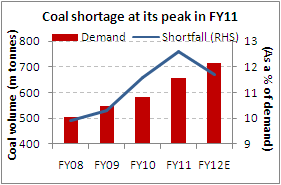- Home
- Research It
- Sector Info
- Power - December 21, 2011
Power Sector Analysis Report 
- With the coming of Electricity Act 2003, the power sector, which was highly regulated with lot of licensing requirements, was supposed to be in the throes of a long awaited change. But things are still happening very slowly on ground. The sector is facing serious delays in terms of capacity expansion. The Eleventh Five-Year Plan (2007-12) target of setting up 78,000 MW of new generation capacity has already been lowered by around 25%. And even the revised target seems unattainable given the current progress.
- The key problems hindering the growth of the power sector are land, fuel, environment, and forest clearances. Even the government is finding it very difficult to get the required land for allotting to power projects. One of the key problems in getting land is Naxalism in the eastern and central states, where a large number of projects are being planned owing to abundance of fuel resources.
- Central institutions like NTPC and the State Electricity Boards (SEBs) continue to dominate the power sector in India. India has adopted a blend of thermal, hydel and nuclear sources with a view to increasing the availability of electricity. Thermal plants at present account for 65% (115,650 MW) of the total power generation capacity in India. This is followed by hydro-electricity (22% share; 37,367 MW). The rest comes from nuclear and wind energy.
- Average transmission and distribution losses (T&D) exceed 25% of total power generation compared to less than 15% for developing economies. The T&D losses are due to a variety of reasons, viz., substantial energy sold at low voltage, sparsely distributed loads over large rural areas, inadequate investment in distribution system, improper billing and high pilferage.
How to Research the Power Sector (Key Points)
- Supply
- Many projects have been planned but due to slow regulatory processes and inadequate equipments and fuel, the supply is far lesser than demand. Currently, India needs to double its generation capacity over the next decade or so to meet the potential demand.
- Demand
- The long-term average demand growth rate is 7-8% per annum and is expected to grow at faster rate in the future.
- Barriers to entry
- Barriers to entry are high, especially in the transmission and distribution segments, which are largely state monopolies. Also, entering the power generation business requires heavy investment initially. The other barriers are fuel linkages, payment guarantees from state governments that buy power and retail distribution license.
- Bargaining power of suppliers
- Not very high as government controls tariff structure. However, this may change in the future.
- Bargaining power of customers
- Bargaining power of retail customers is low, as power is in short supply. However government is a big buyer and payments from it can be erratic, as has been seen in the past.
- Competition
- Getting intense, but there is enough room for many players. The Electricity Act 2003 aims to encourage investments, thereby increasing competition.
Financial Year '11
- Total power generation stood at 811 bn units (BU) in FY11, as compared to 771 BU in FY10. This represented a growth of just around 5%, when the requirement is anywhere around 10-12% per annum. FY11 also witnessed peak shortage in availability of critical fuel coal which hampered capacity addition in the power sector.

Data source: CEA - The average PLF in the Central Public Sector Undertakings and private sector companies was much higher than that achieved by the SEBs as a whole in FY11. Wide inter-state variations were noticed in the average PLF of thermal power plants with southern and northern zones having better performances.
- As far as T&D segments of the sector are concerned, there was little that actually happened in FY11. The country continues to reel under the pressure of higher T&D losses and with the government going very slow with the reforms process in these segments, the long-term sustainable growth of the sector seems doubtful.
Prospects
- Recognising that electricity is one of the key drivers for rapid economic growth and poverty alleviation, the industry has set itself the target of providing access to all households over the next few years. As per government reports, about 36% of the households did not have access to electricity. Hence, meeting the target of providing universal access is a daunting task requiring significant addition to generation capacity and expansion of the transmission and distribution network.
- Coal costs from both domestic linkages and imported sources are expected to be on the rise. Shortfall of coal in India is expected to go up to 100 MMT (m metric tonnes) by FY14. Availability of coal from domestic linkages would suffice only 55 to 60% of the PLF equivalent. Hence purchase of coal by way of Coal India's e-auction would only become more expensive.
- Restoration of the financial health of SEBs and improvement in their operating performance continue to remain a critical issue in the power sector.
- On an overall basis, power distribution has been loss-making business in India. But with the privatization coming in, the investment in transmission and distribution networking is expected to improve.
- Trading in electricity has brought a sea change in the structure of the industry because some parts of country are power surplus and some are deficient. A power trading company buys power from surplus area and sells it in a power deficit area through transmission lines. While the potential for power trading is huge, the regulator has to play a key role in removing all discrepancies that occur in terms of electricity pricing across trading regions.
Related Links for Power Sector
Quarterly Results |
Sector Quote |
Over The Years
|
| |

